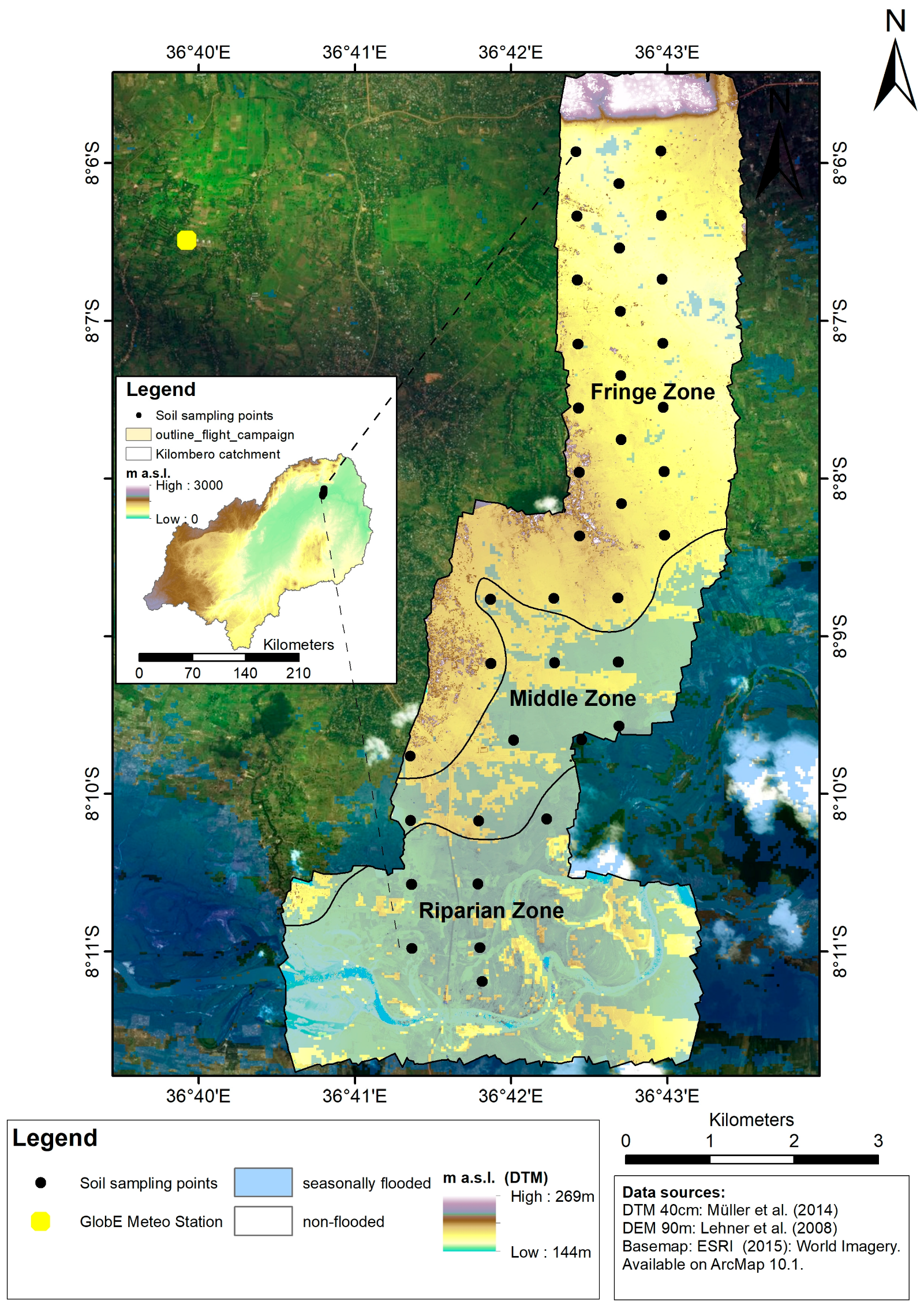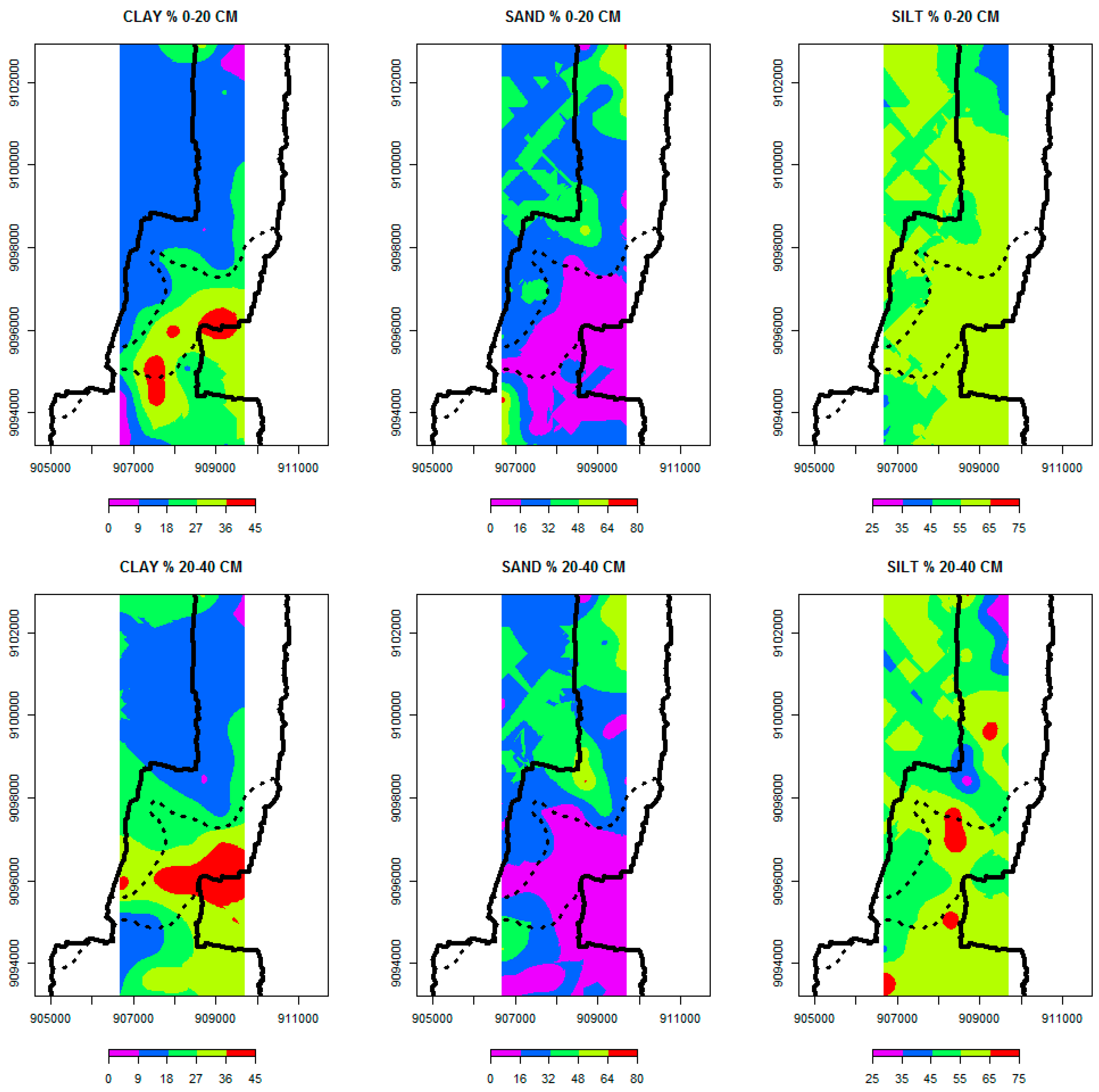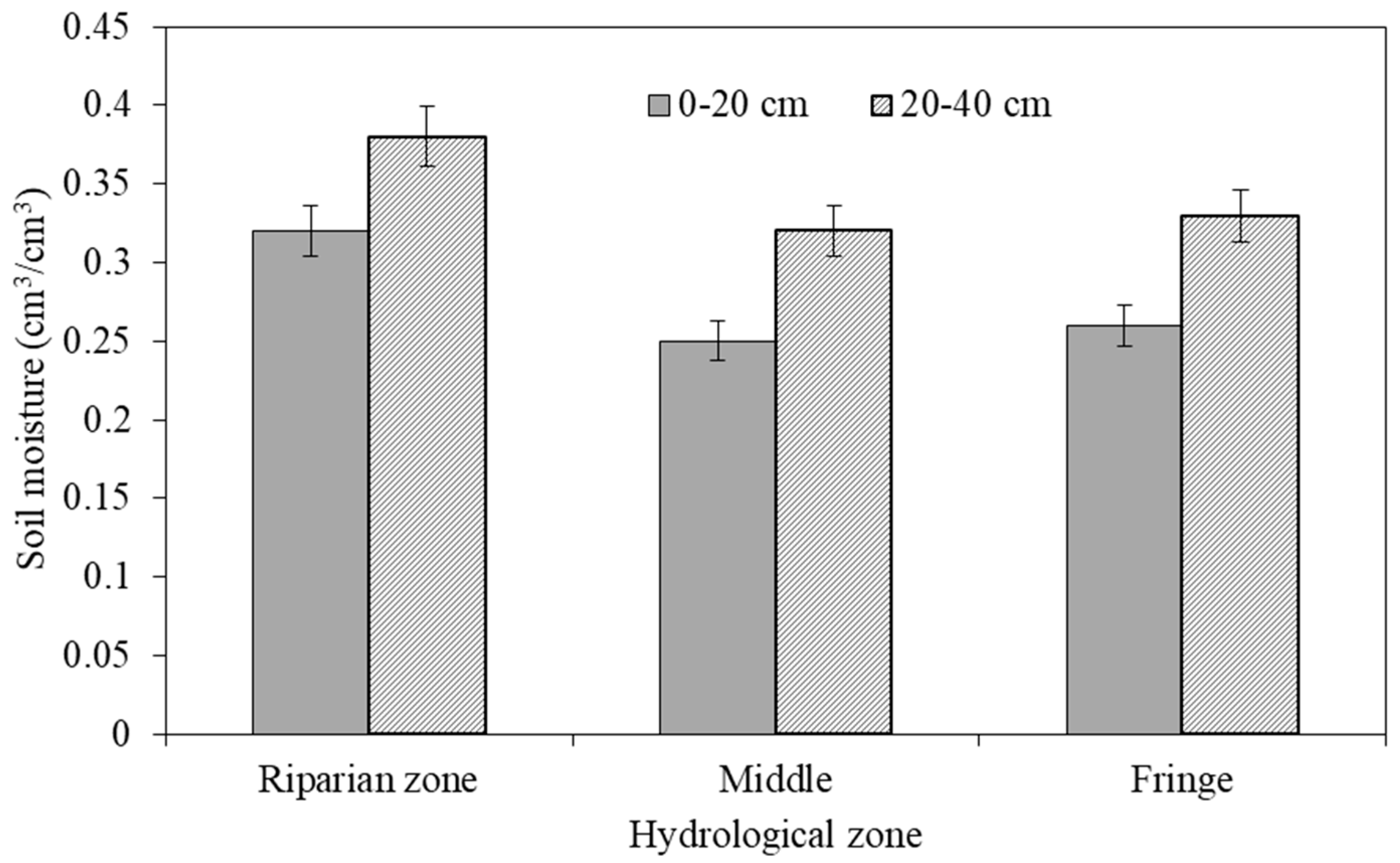Spatial Distribution of Soil Hydrological Properties in the Kilombero Floodplain, Tanzania
Abstract
:1. Introduction
2. Materials and Methods
2.1. Study Area
2.2. Experimental Design
2.3. Soil Sampling and Analysis
2.4. Soil Moisture Monitoring
2.5. Statistical and Spatial Analysis
2.5.1. Classical Statistical Analysis
2.5.2. Geostatistical Spatial Analysis
3. Results
3.1. Variability of Selected Soil Properties
3.2. Spatial Variability of Selected Soil Properties Across the Hydrological Zones
3.3. Geostatistical Analysis of Soil Physical Properties
3.4. Spatial and Temporal Soil Moisture Variability
4. Discussion
5. Conclusions
Acknowledgments
Author Contributions
Conflicts of Interest
References
- Sun, B.; Zhou, S.; Zhao, Q. Evaluation of spatial and temporal changes of soil quality based on geostatistical analysis in the hill region of subtropical China. Geoderma 2003, 115, 85–99. [Google Scholar] [CrossRef]
- Gonzales, O.J.; Zak, D.R. Geostatistical analysis of soil properties in a secondary tropical dry forest, St. Lucia, West Indies. Plant Soil 1994, 163, 45–54. [Google Scholar] [CrossRef]
- Adhikari, K.; Guadagnini, A.; Toth, G.; Hermann, T. Geostatistical analysis of surface soil texture from Zala County in western Hungary. In Proceedings of the International Symposium on Environment, Energy and Water in Nepal: Recent Researches and Direction for Future, Kathmandu, Nepal, 31 March–1 April 2009; pp. 219–224. [Google Scholar]
- Abuduwaili, J.; Tang, Y.; Abulimiti, M.; Liu, D.; Ma, L. Spatial distribution of soil moisture, salinity and organic matter in Manas River watershed, Xinjiang, China. J. Arid Land 2012, 4, 441–449. [Google Scholar] [CrossRef]
- Hupet, F.; Vanclooster, M. Intraseasonal dynamics of soil moisture variability within a small agricultural maize cropped field. J. Hydrol. 2002, 261, 86–101. [Google Scholar] [CrossRef]
- Lal, R.; Shukla, M.K. Principles of Soil Physics; Dekker Inc.: New York, NY, USA, 2004; ISBN 0-8247-5324-0. [Google Scholar]
- Crave, A.; Gascuel-Odoux, C. The influence of topography on time and space distribution of soil surface water content. Hydrol. Process. 1997, 11, 203–210. [Google Scholar] [CrossRef]
- Ngailo, J.A.; Vieira, S.R. Spatial patterns and correlation of soil properties of a lowland soil. J. Soil Sci. Environ. Manag. 2012, 3, 287–296. [Google Scholar] [CrossRef]
- Iqbal, J. Spatial Variability Analysis of Soil Physical Properties of Alluvial Soils. Soil Sci. Soc. Am. J. 2005, 69, 1338–1350. [Google Scholar] [CrossRef]
- Banta, S.; Mendoza, C.V. Organic Matter and Rice; International Rice Institute: Los Banos Laguna, Phillipines, 1984; ISBN 971-104-104-9. [Google Scholar]
- Reddy, K.R.; DeLaune, R.D. Biogeochemistry of Wetlands: Science and Applications; Taylor and Francis GRoup: Boca Raton, FL, USA, 2008. [Google Scholar]
- Wendroth, O.; Reynolds, D.; Vieira, S.; Reichardt, K.; Wirth, S. Statistical approaches to the analysis of soil quality data. In Soil Quality for Crop Production and Ecosystem Health; Elsevier: Amsterdam, The Netherlands, 1997; pp. 247–276. [Google Scholar]
- Santra, P.; Chopra, U.K.; Chakraborty, D. Spatial variability of soil properties and its application in predicting surface map of hydraulic parameters in an agricultural farm. Curr. Sci. 2008, 95, 937–945. [Google Scholar]
- Reza, S.K.; Sarkar, D.; Baruah, U.; Das, T.H. Evaluation and comparison of ordinary kriging and inverse distance weighting methods for prediction of spatial variability of some chemical parameters of Dhalai district, Tripura. Agropedology 2010, 20, 38–48. [Google Scholar]
- Elbasiouny, H.; Abowaly, M.; Abu_Alkheir, A.; Gad, A. Spatial variation of soil carbon and nitrogen pools by using ordinary Kriging method in an area of North Nile Delta, Egypt. CATENA 2014, 113, 70–78. [Google Scholar] [CrossRef]
- Xu, X.; Kalhoro, S.A.; Chen, W.; Raza, S. The evaluation/application of Hydrus-2D model for simulating macro-pores flow in loess soil. Int. Soil Water Conserv. Res. 2017, 5, 196–201. [Google Scholar] [CrossRef]
- Cornelissen, T.; Diekkrüger, B.; Giertz, S. A comparison of hydrological models for assessing the impact of land use and climate change on discharge in a tropical catchment. J. Hydrol. 2013, 498, 221–236. [Google Scholar] [CrossRef]
- Mango, L.M.; Melesse, A.M.; McClain, M.E.; Gann, D.; Setegn, S.G. Land use and climate change impacts on the hydrology of the upper Mara River Basin, Kenya: Results of a modeling study to support better resource management. Hydrol. Earth Syst. Sci. 2011, 15, 2245–2258. [Google Scholar] [CrossRef]
- Yira, Y.; Diekkrüger, B.; Steup, G.; Bossa, A.Y. Impact of climate change on hydrological conditions in a tropical West African catchment using an ensemble of climate simulations. Hydrol. Earth Syst. Sci. 2017, 2143–2161. [Google Scholar] [CrossRef]
- Bormann, H.; Breuer, L.; Gräff, T.; Huisman, J.A. Analysing the effects of soil properties changes associated with land use changes on the simulated water balance: A comparison of three hydrological catchment models for scenario analysis. Ecol. Model. 2007, 209, 29–40. [Google Scholar] [CrossRef]
- Montzka, C.; Moradkhani, H.; Weihermüller, L.; Franssen, H.J.H.; Canty, M.; Vereecken, H. Hydraulic parameter estimation by remotely-sensed top soil moisture observations with the particle filter. J. Hydrol. 2011, 399, 410–421. [Google Scholar] [CrossRef]
- Yang, X. Evaluation and application of DRAINMOD in an Australian sugarcane field. Agric. Water Manag. 2008, 95, 439–446. [Google Scholar] [CrossRef]
- Danvi, A.; Giertz, S.; Zwart, S.J.; Diekkrüger, B. Comparing water quantity and quality in three inland valley watersheds with different levels of agricultural development in central Benin. Agric. Water Manag. 2017, 192, 257–270. [Google Scholar] [CrossRef]
- Yang, H.; Wang, H.; Fu, G.; Yan, H.; Zhao, P.; Ma, M. A modified soil water deficit index (MSWDI) for agricultural drought monitoring: Case study of Songnen Plain, China. Agric. Water Manag. 2017, 194, 125–138. [Google Scholar] [CrossRef]
- Mombo, F.; Speelman, S.; Van Huylenbroeck, G.; Hella, J.; Moe, S. Ratification of the Ramsar convention and sustainable wetlands management: Situation analysis of the Kilombero Valley wetlands in Tanzania. J. Agric. Ext. Rural Dev. 2011, 3, 153–164. [Google Scholar]
- Rebelo, L.-M.; McCartney, M.P.; Finlayson, C.M. Wetlands of Sub-Saharan Africa: Distribution and contribution of agriculture to livelihoods. Wetl. Ecol. Manag. 2010, 18, 557–572. [Google Scholar] [CrossRef]
- Leemhuis, C.; Thonfeld, F.; Näschen, K.; Steinbach, S.; Muro, J.; Strauch, A.; López, A.; Daconto, G.; Games, I.; Diekkrüger, B. Sustainability in the food-water-ecosystem nexus: The role of land use and land cover change for water resources and ecosystems in the Kilombero Wetland, Tanzania. Sustainability 2017, 9. [Google Scholar] [CrossRef]
- Beck, A.D. The Kilombero valley of south-central Tanganyika. East Afr. Geogr. Rev. 1964, 1964, 37–43. [Google Scholar]
- Koutsouris, A.J.; Chen, D.; Lyon, S.W. Comparing global precipitation data sets in Eastern Africa: A case study of Kilombero Valley, Tanzania. Int. J. Climatol. 2016, 36, 2000–2014. [Google Scholar] [CrossRef]
- Nicholson, S.E. A review of climate dynamics and climate variability in Eastern Africa. In The Limnology, Climatology and Paleoclimatology of the East African Lakes; Gordon and Breach: Amsterdam, The Netherlands, 1996; pp. 25–26. [Google Scholar]
- Basalirwa, C.P.K.; Odiyo, J.O.; Mngodo, R.J.; Mpeta, E.J. The climatological regions of Tanzania based on the rainfall characteristics. Int. J. Climatol. 1999, 19, 69–80. [Google Scholar] [CrossRef]
- Hughes, R.H.; Hughes, J.S. A Directory of African Wetlands; IUCN: Gland, Switzerland, 1992; ISBN 978-2-88032-949-5. [Google Scholar]
- Burghof, S.; Gabiri, G.; Stumpp, C.; Chesnaux, R.; Reichert, B. Development of a hydrogeological conceptual wetland model in the data-scarce North-Eastern region of Kilombero Valley, Tanzania. Hydrogeol. J. 2017. [Google Scholar] [CrossRef]
- Department of the Interior, U.S.G.S. Product Guide—Landsat 4–7 Surface Reflectance (LEDAPS) Product Version 8.0. Available online: https://landsat.usgs.gov/sites/default/files/documents/ledaps_product_guide.pdf (accessed on 6 August 2017).
- Department of the Interior, U.S.G.S. Product Guide Landsat 8 Surface Reflectance Code (LASRC) Product Version 4.1. Available online: https://landsat.usgs.gov/sites/default/files/documents/lasrc_product_guide.pdf (accessed on 6 August 2017).
- Okalebo, J.; Gathua, K.; Woomer, P. Laboratory Methods of Plant and Soil Analysis: A Working Manual; Tropical Soil Biology and Fertility Programme: Nairobi, Kenya, 2002. [Google Scholar]
- Horiba Instruments Inc.; Irvine, U. LA950. Available online: http://www.horiba.com/fileadmin/uploads/Scientific/Documents/PSA/LA950_V2_bro.pdf (accessed on 27 November 2017).
- Horiba, S. A Guidebook to Particle Size Analysis. Available online: www.horiba.com/us/particle (accessed on 20 May 2015).
- Eijkelkamp User Manual. Available online: https://en.eijkelkamp.com/products/laboratory-equipment/soil-water-permeameters.html (accessed on 27 November 2017).
- Delta-T Devices Ltd. User Manual for the Profile Probe Type PR2. Available online: ftp://ftp.dynamax.com/manuals/PR2_QSG.pdf (accessed on 3 March 2014).
- Delta-T Devices Ltd. User Manual for the Moisture Meter Type HH2. Available online: http://www.delta-t.co.uk/wp-content/uploads/2016/10/HH2-UM-4.2.pdf (accessed on 3 March 2014).
- Wilding, L.G. Soil spatial variability: Its documentation, accommodation and implication to soil surveys. In Soil Spatial Variability Proceedings of a Workshop of the ISSS and the SSA, Las Vegas PUDOC, Wageningen; Center Agricultural Pub and Document, Pudoc Wageningen: Wageningen, The Netherlands, 1985; pp. 166–187. [Google Scholar]
- Webster, R.; Oliver, M.A. Geostatistics for Environmental Scientists, 2nd ed.; Wiley: Chichester, UK, 2007; ISBN 978-0-470-02858-2. [Google Scholar]
- Hengl, T. A Practical Guide to Geostatistical Mapping, 2nd ed.; Hengl: Amsterdam, The Netherlands, 2009; ISBN 978-90-90-24981-0. [Google Scholar]
- Childs, C. Interpolating surfaces in ArcGIS spatial analyst. ArcUser Jul.–Sept. 2004, 3235, 569. [Google Scholar]
- Huang, Y.; Wang, Y.; Zhao, Y.; Xu, X.; Zhang, J.; Li, C. Spatiotemporal distribution of soil moisture and salinity in the taklimakan desert highway shelterbelt. Water (Switzerland) 2015, 7, 4343–4361. [Google Scholar] [CrossRef]
- Stockton, J.; Warrick, A. Spatial variability of unsaturated hydaulic conductivity. Soil Sci. Soc. Am. J. 1971, 35, 201–205. [Google Scholar] [CrossRef]
- Arshad, M.A.; Martin, S. Identifying Critical Limits for Soil Quality Indicators in Agro-Ecosystem. Agric. Ecosyst. Environ. 2002, 88, 153–160. [Google Scholar] [CrossRef]
- Maurice, K.; Boniface, O.; Francis, P. Intensity of Farmland Cultivated and Soil Bulk Density in Different Physiographic Units in Nyakach District. IOSR J. humanit. Soc. Sci. 2014, 19, 86–91. [Google Scholar]
- Rawls, W.J. Estimating soil bulk density from particle size analysis and organic matter content. Soil Sci. 1983, 135, 123–125. [Google Scholar] [CrossRef]
- Hunt, N.; Gilkes, B. Farm Monitoring Handbook; University of Western Australia, Land Management Society, and National Dryland Salinity Program: Crawley, Australia, 1992. [Google Scholar]
- McKenzie, N.; Coughlan, K.; Cresswell, H. Soil Physical Measurement and Interpretation for Land Evaluation; CSIRO Publishing: Clayton, Australia, 1992; Volume 5, ISBN 9780643069879. [Google Scholar]
- Loveland, P.; Webb, J. Is there a critical level of organic matter in the agricultural soils of temperate regions: A review. Soil Tillage Res. 2003, 70, 1–18. [Google Scholar] [CrossRef]
- Doran, J.W.; Elliott, E.T.; Paustian, K. Soil microbial activity, nitrogen cycling, and long-term changes in organic carbon pools as related to fallow tillage management—Iowa State University. Soil Tillage Res. 1998, 49, 3–18. [Google Scholar] [CrossRef]
- De Vos, B.; Van Meirvenne, M.; Quataert, P.; Deckers, J.; Muys, B. Predictive Quality of Pedotransfer Functions for Estimating Bulk Density of Forest Soils. Soil Sci. Soc. Am. J. 2005, 69, 500–510. [Google Scholar] [CrossRef]
- Faulkner, S.P.; Richardson, C.J. Physical and chemical characteristics of freshwater wetland soils. In Constructed Wetlands for Wastewater Treatment: Municipal, Industrial and Agricultural; Hammer, D.A., Ed.; Lewis Publishers: Boca Raton, FL, USA, 1989; pp. 41–72. [Google Scholar]
- Abaci, O.; Papanicolaou, A.N. Long-term effects of management practices on water-driven soil erosion in an intense agricultural sub-watershed: Monitoring and modelling. Hydrol. Process. 2009, 23, 2818–2837. [Google Scholar] [CrossRef]
- Gicheru, P.; Gachene, C.; Mbuvi, J.; Mare, E. Effects of soil management practices and tillage systems on surface soil water conservation and crust formation on a sandy loam in semi-arid Kenya. Soil Tillage Res. 2004, 75, 173–184. [Google Scholar] [CrossRef]
- Mulebeke, R.; Kironchi, G.; Tenywa, M.M. Soil moisture dynamics under different tillage practices in cassava–sorghum based cropping systems in eastern Uganda. Ecohydrol. Hydrobiol. 2013, 13, 22–30. [Google Scholar] [CrossRef]





| Soil Property | n | Mean | SD | Min | Max | Median | CV (%) |
|---|---|---|---|---|---|---|---|
| BD (g∙cm−3) | 76 | 1.38 | 0.13 | 1.00 | 1.70 | 1.39 | 9.70 |
| SOC (g∙kg−1) | 76 | 11.1 | 5.2 | 1.40 | 25.7 | 10.8 | 47.04 |
| Ksat (cm∙d−1) | 76 | 41.73 | 64.75 | 4.00 | 478.2 | 25.66 | 155.2 |
| Sand (%) | 76 | 27.10 | 20.61 | 1.04 | 72.21 | 26.66 | 76.05 |
| Silt (%) | 76 | 53.71 | 13.09 | 25.96 | 74.28 | 55.94 | 24.37 |
| Clay (%) | 76 | 19.19 | 11.62 | 1.17 | 47.27 | 14.40 | 60.55 |
| Soil Depth | Hydrological Zone | n | BD (g∙cm−3) | SOC (g∙kg−1) | Ksat (cm∙d−1) | Sand (%) | Silt (%) | Clay (%) |
|---|---|---|---|---|---|---|---|---|
| 0–20 cm | Riparian | 9 | 1.26 | 10.9 | 68.2 | 27 | 53.8 | 19.2 |
| Middle | 9 | 1.31 | 12 | 29.8 | 14.1 | 59.3 | 26.6 | |
| Fringe | 20 | 1.41 | 13 | 27.9 | 33.7 | 52 | 14.3 | |
| 20–40 cm | Riparian | 9 | 1.31 | 9.4 | 70.1 | 20.7 | 58 | 21.3 |
| Middle | 9 | 1.43 | 10.4 | 35 | 12.4 | 56.9 | 30.8 | |
| Fringe | 20 | 1.46 | 10.1 | 39.3 | 35.9 | 49.5 | 14.6 | |
| p-value (depth) | 0.016 | NS | NS | NS | NS | NS | ||
| p-value (hydrologic zones) | <0.001 | NS | NS | <0.001 | NS | <0.001 | ||
| Soil Property | Depth (cm) | Model | Lag Size | Nugget (C0) | Range | Partial Sill (C) | Spatial Dependence (C0/C0 + C) × 100 | RMSE |
|---|---|---|---|---|---|---|---|---|
| BD (g∙cm−3) | 0–20 | Exp | 204.16 | 0.01 | 2449.97 | 0.01 | 43.36 | 0.12 |
| 20–40 | Exp | 156.68 | 0.00 | 1277.13 | 0.01 | 0.00 | 0.11 | |
| Silt (%) | 0–20 | Exp | 157.72 | 95.54 | 1244.62 | 80.99 | 54.12 | 13.95 |
| 20–40 | Exp | 159.83 | 0.00 | 1463.32 | 175.80 | 0.00 | 12.39 | |
| Clay (%) | 0–20 | Exp | 442.81 | 0.00 | 2815.90 | 138.76 | 0.00 | 9.88 |
| 20–40 | Exp | 649.99 | 15.25 | 5568.68 | 170.29 | 8.22 | 10.26 | |
| Sand (%) | 0–20 | Exp | 158.77 | 0.00 | 1244.62 | 409.47 | 0.00 | 20.70 |
| 20–40 | Exp | 202.82 | 0.00 | 1984.02 | 377.72 | 0.00 | 17.28 | |
| SOC (g∙kg−1) | 0–20 | Exp | 280.49 | 0.20 | 3365.94 | 0.12 | 62.47 | 0.52 |
| 20–40 | Exp | 168.51 | 0.00 | 1273.26 | 0.29 | 0.00 | 0.48 |
© 2017 by the authors. Licensee MDPI, Basel, Switzerland. This article is an open access article distributed under the terms and conditions of the Creative Commons Attribution (CC BY) license (http://creativecommons.org/licenses/by/4.0/).
Share and Cite
Daniel, S.; Gabiri, G.; Kirimi, F.; Glasner, B.; Näschen, K.; Leemhuis, C.; Steinbach, S.; Mtei, K. Spatial Distribution of Soil Hydrological Properties in the Kilombero Floodplain, Tanzania. Hydrology 2017, 4, 57. https://doi.org/10.3390/hydrology4040057
Daniel S, Gabiri G, Kirimi F, Glasner B, Näschen K, Leemhuis C, Steinbach S, Mtei K. Spatial Distribution of Soil Hydrological Properties in the Kilombero Floodplain, Tanzania. Hydrology. 2017; 4(4):57. https://doi.org/10.3390/hydrology4040057
Chicago/Turabian StyleDaniel, Stephen, Geofrey Gabiri, Fridah Kirimi, Björn Glasner, Kristian Näschen, Constanze Leemhuis, Stefanie Steinbach, and Kelvin Mtei. 2017. "Spatial Distribution of Soil Hydrological Properties in the Kilombero Floodplain, Tanzania" Hydrology 4, no. 4: 57. https://doi.org/10.3390/hydrology4040057





